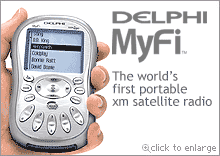 So Friday night I came home after a long day of running appliance service calls and Mrs. Samurai surprised me with an early Christmas present. Oh, take your mind out of the gutter! She bought me the new XM MyFi set (would it be too corny to say she bought me an XMas present? ok, nevermind). In case you’ve been too busy drinking Bud and watching Gilligan, XM is the largest of the two big subscription satellite radio services; the other is Sirius. I already subscribed to Sirius earlier this year and have been an acolyte at the altar of satellite radio ever since. As a dutiful American consumer, doing my part to power the economy by spending money on stuff I don’t really need, I adhere to the motto that, “More is better.” So now I subscribe to both satellite radio services!
So Friday night I came home after a long day of running appliance service calls and Mrs. Samurai surprised me with an early Christmas present. Oh, take your mind out of the gutter! She bought me the new XM MyFi set (would it be too corny to say she bought me an XMas present? ok, nevermind). In case you’ve been too busy drinking Bud and watching Gilligan, XM is the largest of the two big subscription satellite radio services; the other is Sirius. I already subscribed to Sirius earlier this year and have been an acolyte at the altar of satellite radio ever since. As a dutiful American consumer, doing my part to power the economy by spending money on stuff I don’t really need, I adhere to the motto that, “More is better.” So now I subscribe to both satellite radio services!
Oh, I know what you’re thinking, “Well, Mr. Samurai money-bags, you must be getting rich doing appliance repair to be able to afford all that!” All what? The monthly subscription fee for XM is only $9.95 and Sirius is $12.95. Even combined, that’s a lot less than the typical cable TV monthly bill and since we don’t do TV in our house, that leaves lots of money left over for beer! What’s your next question?
“Ok, Mr. Smarty-pants Samurai, well, uhh, why’d your wife get you XM if you already had Sirius?”
Good question, thanks for asking. It really came down to the hardware rather than the programming. The programming between each service is very similar: dozens of commercial-free, CD-quality music channels, and dozens of news and talk channels including all the usual suspects such as Faux News, Communist News Network (CNN), Bloomberg Bidness News, C-Span, and BBC.
In my much sought-after opinion, which I’ll give you here for free, Sirius has a slightly better news lineup. XM has a slightly better talk lineup. For example, XM carries three of my favorite radio shows: The World-Famous Phil Hendrie Show, The Rollye James Show, and Coast to Coast AM. Both carry my favorite investment show, MoneyTalk.
The music lineup of XM and Sirius are very similar. The main difference is that Sirius has unique DJ personalities, some of whom are very entertaining, whereas XM runs its music channels largely on autopilot. Some audiogeeks claim they can hear a difference in the music quality. Depending on who you talk to, some say XM sounds better while others say Sirius sounds better. I can’t tell a difference–they’re both CD-quality sound and any differences in sound quality is probably more a function of your audio equipment rather than the satellite service.
But my dear wife saw me drooling over the sexy new XM MyFi rig. The appeal with this hot little gizmo is that it’s small, portable, and includes everything you need to listen to XM at home, in your vehicle, or while walking. I’ve read some cheesedorks whining about the $350 price tag but this is nothing more than naive petulance from the “gimme something for nothing” crowd. Look at all the equipment that’s included with the MyFi package, along with the receiver (shown above):

I’ve spent at least that much on the various docking stations and other equipment so I could listen to Sirius in my bedroom (I like to drift off to sleep while listening to the radio), my downstairs workstation, and my service van.
And the Sirius equipment didn’t come with the Tivo-like feature that the MyFi has where you can record five hours of programming. This was the big selling feature for me. Now I can record one of my favorite shows on the MyFi then clip it to my belt and listen on the go. One especially cool feature is that you can skip through commercials by just pressing a key; it’s not a fast forward, either, it skips right to the next segment. Waaaay cool.
Since the audio is stored in flash memory, not an iPod-esque mini hard drive, battery life of the MyFi is excellent. I don’t know how long yet, but I do know that the battery lasts far longer than the five-hour recording memory capacity because I still have full battery bars after listening to five hours of recorded audio.
The only thing I wish Delphi (the manufacturer of the MyFi) had included is a sandisk memory expansion slot. With a 512 mb sandisk, you could increase the record time from five hours to 18 hours, maybe more.
These two new satellite radio services will force land-based broadcast radio to change or become obsolete. Broadcast radio, in its current format, sucks: eight minutes of pap followed by four minutes of commercials and all the same bland diet of pap and pablum. We can thank the FCC for much of broadcast radio’s current sorry state of affairs. Many smaller, community-based radio stations, such as WNTK here in the Upper Valley region of New Hampshire and Vermont, are operating on shoestring budgets. So when the FCC, the Keystone cops of the airwaves, threatens to levy fines for indecency (which, incidentally, is not defined anywhere in the FCC rules–it’s all complaint-driven) these smaller stations are so paralyzed with fear they they dare not innovate or air controversial shows or personalities.
With the advent of satellite radio, the days of the nationally syndicated talk shows and corporate music playlists are numbered. Why put up with that crap when you can get a larger selection of better talk shows and commercial-free music all in CD-quality sound by going to satellite radio? The only salvation for broadcast radio will be local color: local talk shows such as WNTK’s Morning Liftoff, local news, local weather. Leave the one-size-fits-all programming to the big birds in the sky.

